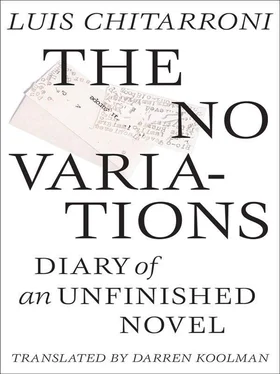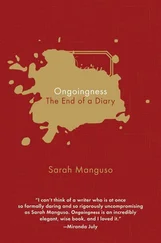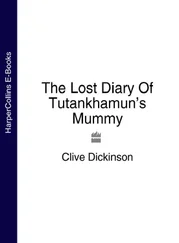Prolonged silence. Then tactfully, furtively, with dignified misgiving, Zi added: “Of course being with friends at all those literary conferences, whether in Mexico or River Plate, helps make the time pass by more quickly …” But Aída and Hernán were still suspicious so he finally confessed that everything he said was actually [in reality] just the précis of a story he was writing called “The Motive,” that he intended to publish and distribute in the form of fliers around Buenos Aires. For free, of course. We all demanded copies.
11.48. Initial assertion on the artificiality of memory followed by [simpatico] effusions on said topic. Photos taken, then more toasting.
11.51. The Venusón of Guadalajara, they say, was built at the start of the twentieth century, and is distinguished for having been modeled a la manière of the most exquisite houses of ill-repute in New Orleans. For this, they gathered together three architects, two painters of the academic style, and a gringo [Greek] pimp: Milos (afterwards, Eros) Catsaunis, who brought along the first employees — Hungarians, made available by the generous Zwi Migdal Foundation. In 1901, there were already one hundred pupils. As a principle of order, the first madam (ex-principal of a rural public school) decided to give them all new names, using a triadic or tripartite alphabetical criterion (Amanda Albéniz Amadis, Fátima Fajardo Fez, Zenobia Zilphia Zardos), and to group them accordingly within stables, each group’s designation being the first names of each of the five ladies in that group, the designation being pronounced rhythmically after an iambic or amphibrachic pattern, with all groups together, of course, forming part of a single group, that Fourier-inspired phalanstary called the Venusón. In the early days — the Belle Époque , specifically, but above all in Mexico — the Venusón was run by a committee, each of whose members was supplied with a catalogue (basically, a large photo album). Aída still has the one she inherited from her grandfather, an eminent hygienist who’d made a memorable contribution (I can’t remember the year, but Aída wrote it down somewhere) in enforcing the use of Venusiline (or Veniciline, as it’s called in old manuals and dated encyclopedias).
Famélica Fátima íntima , crooned Luini.
12.02. We hear a distinctively whiny voice coming from outside. Turn to see a boy on the pier, leaning over the gunnel, holding a basket. He was watching us attentively. Such serious eyes, he smiled a toothless smile. Luini passed a [frivolous] remark about the poor being more varied and interesting than the rich [the poverty of enrichment]: the rich look the same wherever you go, but a city is made distinctive by its poor. Indeed, it is the poor we erect as models to be imitated, it is they that easily pass through the eyes of needles. He gave some examples, to boot (the castle, the museum, the oasis) …
The boy offered us corn, marijuana, axolotls, magic mushrooms, more tequila, Angostura bitters, a mercury or cinnabar casserole (which came with a clarification: specular soup for the reptilian brain ). Zi wanted to try it, in spite (or as a result) of Hernán telling him it had hallucinogenic effects (similar to those brought on by severe fasting, according to a mendicant monk he knows who spends his summers on Mount Athos).
Asked to describe it, Hernán said it was a colloidal substance, with a taste like rolled oats mixed with a drop of sacramental wine (Nebbiolo or Semillon), which he remembers from his boyhood. He said he got used to the taste of the soup during a long trip around Patagonia with his stepmother. As regards its consistency, he tried to be precise (recalling his studies in chemistry) and therefore once again began by insisting it was a colloidal substance … something he had as a boy … like rolled oats and sacramental wine … In the end, we bought a parrot Aída fell in love with. It flitted from shoulder to shoulder and then became like the Paraclete of scripture or Felicité’s little mascot in that sentimental though charming provincial parable of Flaubert’s.
12.05. A look at the watch, then the sky. Clouds like nurses escort the sun unhurriedly in this climate. We were all sweltering in the heat, panting; moving was too much effort, speaking … cyanosis. Then, mercifully, a warm breeze’s caress, delightful and refreshing as a cold spray, and Aída was enlivened enough to point out the jacaranda and bougainvillea flowers joggling in response outside. Then a butterfly floundered in, hairy and (begging forgiveness of lepidopterists) repulsive, lighting on Aída’s tanned elbow. Once settled there, Aída took aim and burst it like an apricot or an overripe persimmon … some kind of fruit in any case.
Then Aída — who had a talent for persuading others to abandon a trite subject — performed a quiet gesture to suggest we forget the incident. But, luckily, Hernán brought his camera.
Haiku, improvised (drunkenly) by Luini: The butterfly / angel in my sleep / demon at my wake . Not a proper Haiku. According to the rules, seventeen syllables.
Having been abandoned by Psyche my soul , I was reminded of the book ( because I do not hope ) that led us to go to Mexico that first time: Zi Benno and I; not Luini. Luini was, is , in every sense of the word, a parvenu .
12.08. A gathering of geniuses in Tlalpan — Einstein, Niels Bohr, Heisenberg, Max Planck, Pauli — and later (as if answering a casting call) — Crick, Oppenheimer, Fermi, Watson, Pauling, de Broglie, etc. This absurd convention defied all rationale: it was the crazy whim of the most important writer in Mexico at the time (whom our friends from the previous night prohibited us mentioning in their presence … luckily we were now in different company!).
Zi and I completed our monographs on time (which were published in The Notebooks of Tlalpan in summer, 1992, and for which, more importantly, we were remunerated). Without the need of Psyche or headphones, I could suddenly hear mingled unsettling cadences from the recent past, the sounds of Amon Düül and Ash Tempel. Howling hordes traversing the steppe [between things forgotten and remembered] avoiding the others, but charging straight for “me.”
Yma Sumac, anyone? Aída to the rescue. A DJ persecuted us before in a similar boat. Then Luini seemed to vanish as my soul rose up and up.
12.12. From a great height, I could see the tiny dot of our boat, and I prayed to return to myself. We all prayed to get close to one another. But the supplication was to no avail, for the prayer was quenched in the utterance. For afterwards, when I opened my eyes, I could see the jungle stretching in the distance, the water of the river lap the shoreline. And then, still presbyopic, I squinted on a little bark where four were tirelessly rehearsing sham civilities — imperceptible in vitro , but, otherwise, obvious — and a fifth, forcing himself to cooperate in the farce, which would seem less ridiculous with repeated exercises in loyalty.
Then I peered at the telltale oval of my watch (sixteen after twelve) and made an effort to rejoin the conversation.
Postscriptum, airport : look again at my wristwatch. Not much elbow room inside that little case. How the hell does Time cover so much ground?
12.17. We spoke again about the Venusón of Guadalajara. At the end of the fifties there was a change of ownership. The girls could now call themselves whatever they wished: Glenda Brian, Pussy Brain, Bermaine [Vermin] Greer, Xenia Brainiac. At the end of the seventies, the establishment itself got a new name (although it seems the large neon sign at the front wasn’t taken down). It was a time when many changes were made, and many shady deals. There was also a newsletter released revealing the names of many notables who’d once attended. Aída jogged her memory again: W. C. Fields, Haile Selassie, John Garfield, Greta Garbo, Elvis Presley, JFK, Ian Fleming, Lee Falk, Lee Hazlewood, Serge Gainsbourg, TL (Tom Lehrer? Timothy Leary?), and an Argentine (to whom I’ll also refer with initials because of my strong bond of friendship with his direct descendant): H.C.
Читать дальше












